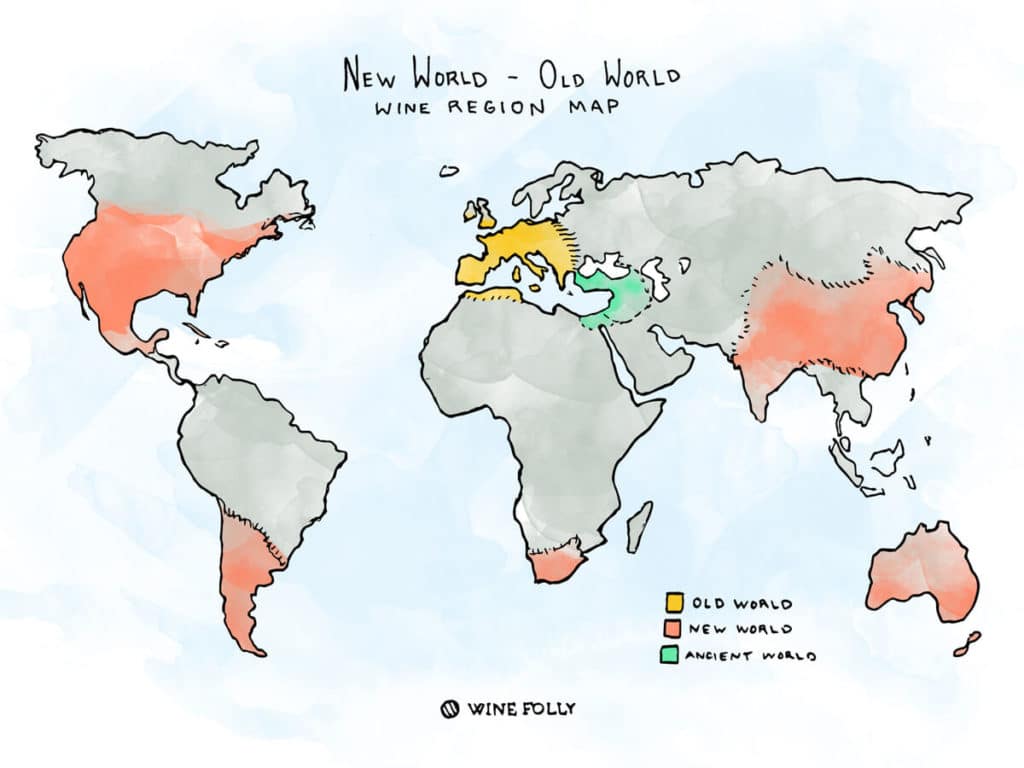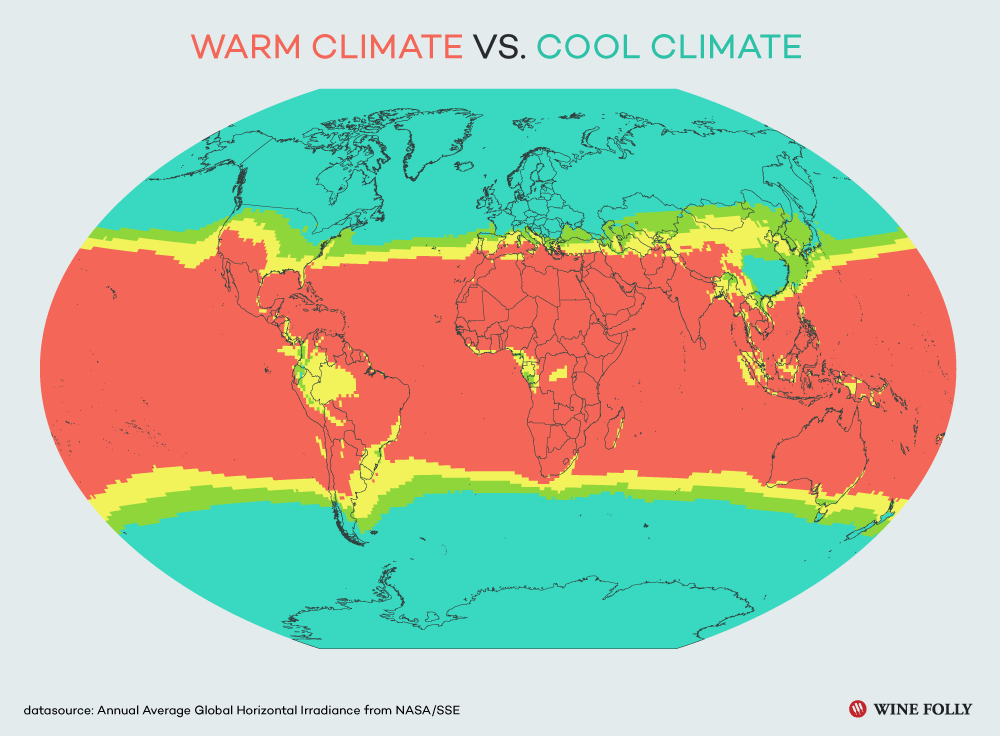What is the Difference Between Old World Wine and New World Wine?
First, let’s answer the question: what and where are we talking about when we say the “new world” and the “old world?”
Generally, the list of countries considered part of the old world are: Italy, France, Spain, Portugal, and Germany. And the list of countries considered part of the new world are: USA, Canada, Argentina, Chile, South Africa, Australia, and New Zealand.
Here’s a helpful map from Wine Folly:

Side note: You’ll also see the area noted as “Ancient World.” This area, in and around the Caucasus Mountains, is where the oldest evidence of winemaking has been found. The history of wine goes back a loooong time! However, the most frequently discussed distinction is between old and new world wine.
Old World vs. New World
Most basically, winemakers of the old world laid the foundation for present-day winemaking by defining the “classic” flavor profiles and techniques. The new world then interpreted those traditions for new soils, climates, and technologies. Also, keep in mind that many of the regions of the “new” world have been producing wine since approximately 1500 CE. Vine growing and winemaking generally arrived in places outside of Europe through European colonization and the subsequent importing of their beloved vines and wines.
And while there are no hard and fast rules for what an old world or new world wine must taste like, we’ve narrowed it down to three things you can normally expect to find in a wine of each category…
Three common attributes of old world wine:
-
- Fresher + higher acidity
- Produced in cooler climates
- Lower alcohol
Fresher + higher acidity
Let’s first talk about “freshness” in wine. Think of a cucumber; cucumbers are fresh. They provide a little “pop” to the palate with that crunchy, watery zip. No sugar needed. In wine we call that “zip” or “nerve” or “energy” acidity. Classic, old world wine styles need acidity to balance even the richest reds. Additionally, as opposed to crunchy grape skins in your wine glass (which would be nasty but I’m sure has been thought of), old world wines strive to achieve balanced tannins and minerality as a compliment to acidity. These elements produce the satisfying freshness associated with popular old world red wines made from grapes like Sangiovese, Cabernet Franc, and Pinot Noir.
Produced in cooler climates
Much of this freshness is possible because the grapes are grown in a cooler climate than most new world regions. While there are definitely warmer climates within wine-producing regions of the old world (think of Puglia, Italy), compared to the heat of Chile, Argentina, and parts of California, the old world starts looking pretty mild.
Lower alcohol
A cooler climate means that the grapes won’t naturally develop high sugar levels. And because alcohol levels in a finished wine are directly related to the amount of sugar present in the grapes when they are picked (less sugar means less fuel for the yeast to turn into alcohol), this results in lower ABV wines in the old world.
Here’s another helpful map from Wine Folly that maps cool vs. warm regions:
Three common attributes of new world wine:
-
- Produced in warmer climates
- Higher alcohol
- Pronounced fruit and rich oak flavors + big bodied
Produced in warmer climates
US wine production is predominantly in warm climates like California’s Central Coast or Walla Walla in Washington State where international varietals like Chardonnay, Zinfandel, Cabernet Sauvignon, and Merlot enjoy long, hot growing seasons. Other new world countries like Chile, Argentina, and Australia have similar climates that also yield success with these varietals.
Higher Alcohol
Remember how hotter climates will create more sugar in the grapes? These higher levels of sugar convert to alcohol during fermentation and create more robust alcohol levels in wine. While, in general, wines from warmer climates typically have higher alcohol levels it is also possible to restrain sugar levels through intense canopy management (how many leaves you leave on the vine to block sun), or, less commonly, picking the grapes at desired sugar levels in order to have lower alcohol wines.
Pronounced fruit and rich oak flavors + big bodied
The wines produced in these places are much “bigger,” hitting higher alcohol levels naturally, and containing more intense primary fruit flavors and rich oak notes. On average, these bigger styles also have a dose of either natural (residual) sugar or added sugar, which producers mask through modern winemaking techniques. This sweetness contributes to the feeling of “weight” in these wines.
It is also worth noting that big, fruit and oak driven wines are commercially successful in the United States so it’s hard to dial back any of that intensity if you’re looking to make wines for immediate retail success. Most Americans drink wines from America. This isn’t a symbol of ardent patriotism, it’s simply because US wines are readily available, are delicious, and hit all the price points consumers look for.
To be clear, most of the “classic” producers that put Napa on the map in the early days made wines that reflected European taste profiles. The “Napa sprawl” still seen at historic sites like Heitz Cellar reflect the history of the valley. A wild, seemingly unmanaged canopy of leaves shields bunches from extreme heat while allowing farmers to focus on vine health and realize a little stronger yield to attain elegant, old-school Napa flavors.
Volio’s take on this (and what we love about old world wines)
Discovering old world wines after mostly drinking wines from the New World can feel like pouring in the foundation of a home after the house has been built. It can be difficult for wine drinkers to find pleasure in European wines if one compares the more lifted flavor profile of many old world wines to the deeper, heavier profiles of warmer-climate Cabernet Sauvignon, Merlot, Zinfandel, or Malbec.
The trifecta of soft grape tannins, a little minerality, and the present acidity in the mouth, are critical to a balanced red wine. From there, it is all about appreciating the wine for what it is, and developing a sense of what wines you find enjoyable. At the end of a night with friends, judge the best wines by the empty bottles on the table. Typically, even new-world-loving crowds will crush bottles of fresh, old world whites and reds while the “heavier” wines from California remain half full.
There are beautiful wines produced in every grape-growing region of the world so it would be unfair to argue a hierarchy between the “old” and “new” world. That said, the standards of quality that most people develop are reflective of classic winemaking styles, which were born in the old world (think of wines from Bordeaux, Chianti Classico, Barolo, Champagne, etc.). As younger wine regions develop their signature styles and a new generation of winemakers interpret the classics, we see exciting, creative wineries popping up all over the world.
But regardless of “new” or “old,” the most fascinating thing about wine is discovering how the unique soil and climate and history of each vine-growing region combines to express itself in the finished wine. This is what we mean when we talk about “terroir.”
So go buy a Chardonnay from Burgundy, France and drink it next to a Chardonnay from the Sonoma Coast, California. Or try a Pinot Noir from the Languedoc next to one from Oregon or New Zealand. In addition to this being a very fun way to learn geography, it illustrates how the origin of a wine directly affects its flavor profile, even when comparing wines made with the same varietal.
At the end of the day, the most important thing is to figure out what is good to you. The most rewarding approach is to appreciate each bottle for what it is…not what it isn’t.
By: Charles Lazzara
– – – – –
If you enjoyed this post, sign up for our newsletter below to receive regular educational content and updates from Volio!

